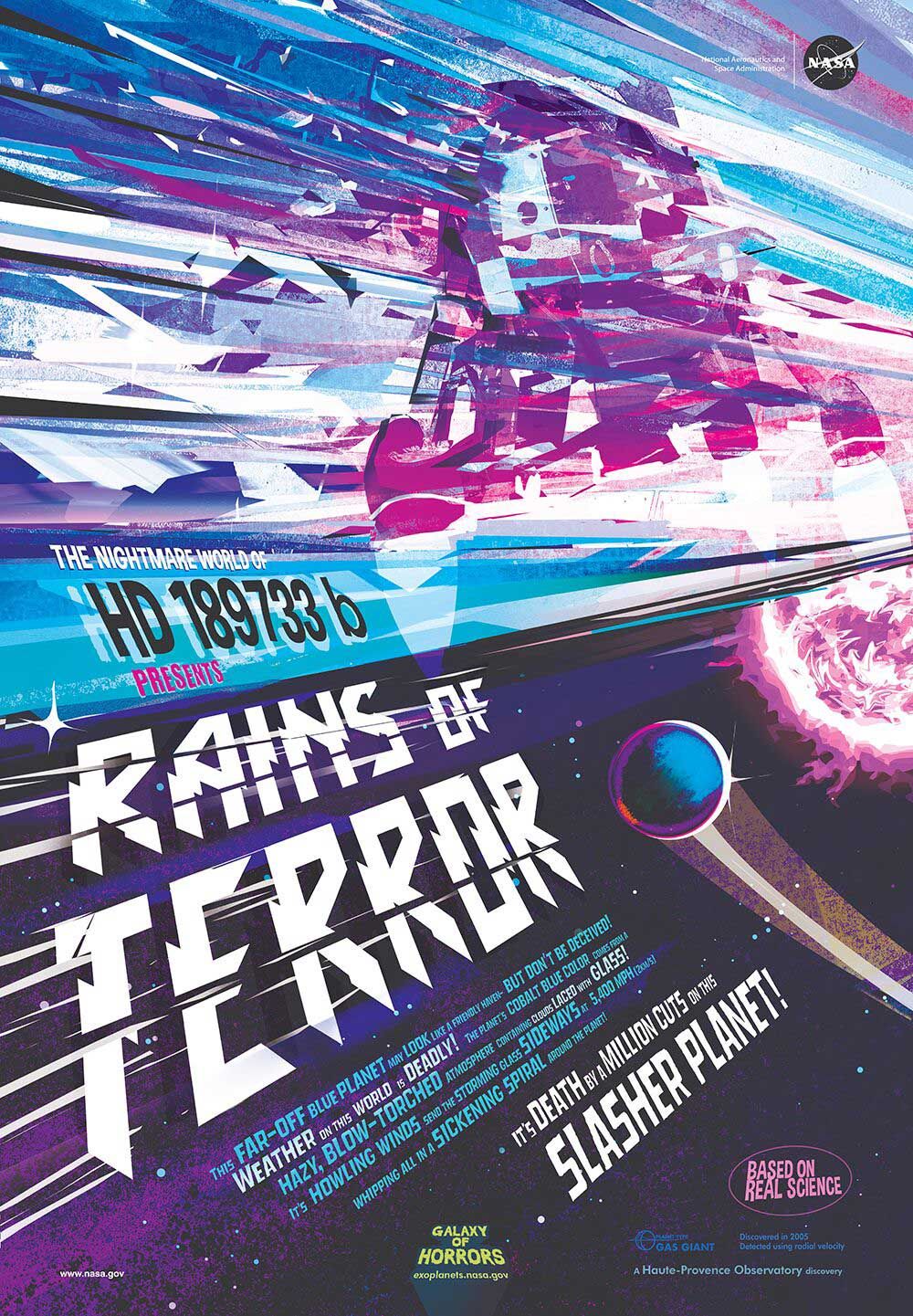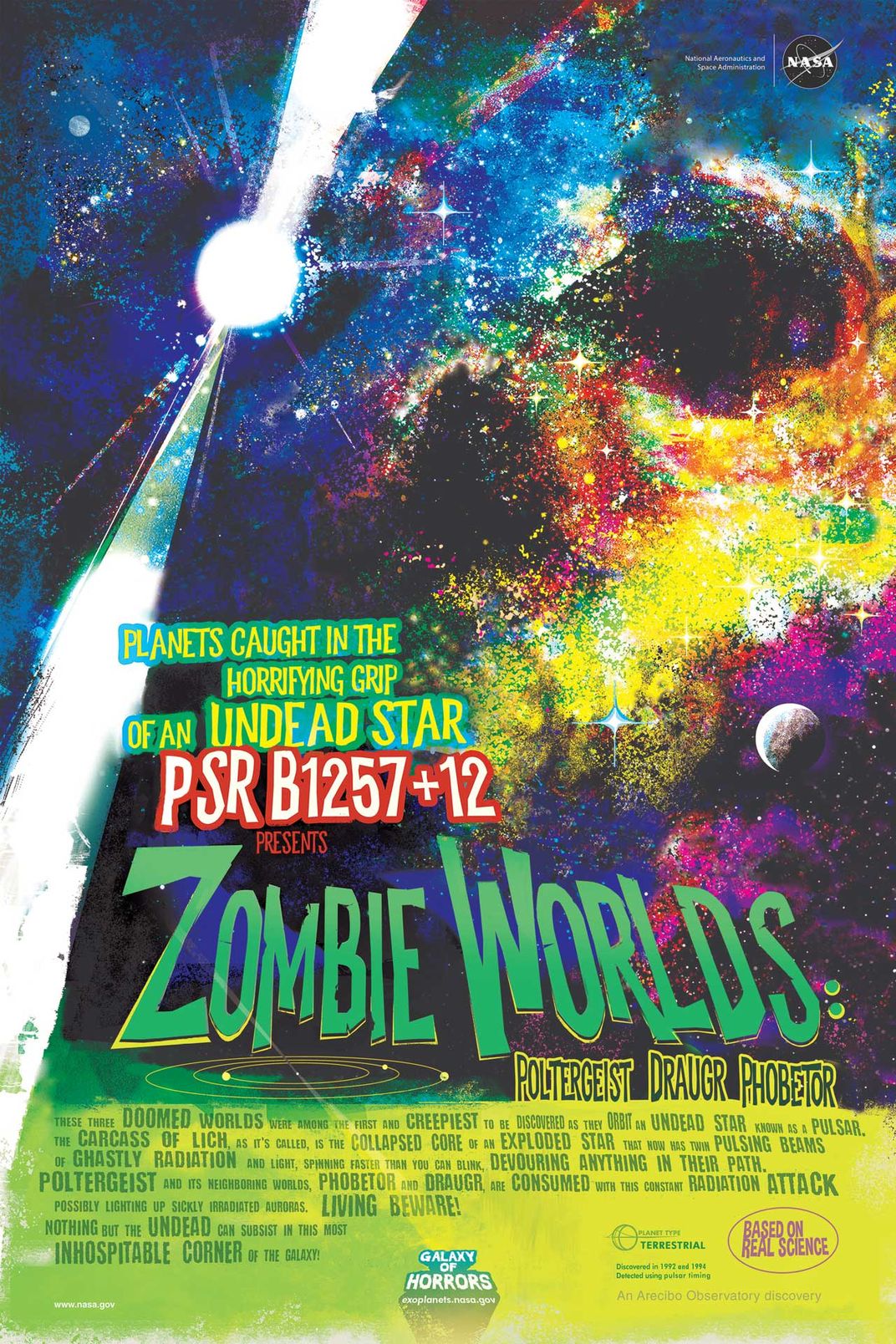NASA Celebrates Halloween With These Interstellar Horror Posters
The artwork highlights the weird world of exoplanets where it rains glass and planets circle zombie stars
/https://tf-cmsv2-smithsonianmag-media.s3.amazonaws.com/filer/d6/de/d6dea619-06d2-4758-b825-b63a19bd3325/screen_shot_2019-10-30_at_40717_pm.png)
Since researchers began cataloguing exoplanets in the 1990s, they’ve discovered more than 4,000 other planets of all sizes and levels of weirdness. Just in time for Halloween, NASA has released a poster series the adds a spooky twist to the search for worlds beyond our solar system—and you can print them all for free.
The two posters in the series—called Galaxy of Horrors!—are made to look like vintage horror movie posters, except instead of promoting The Swamp Thing or The Mummy, they explore a few of the terrifying planets astronomers have found.
The first poster depicts a cobalt-blue planet called HD 189733 b, according to a NASA press release. That exoplanet, discovered in 2005 orbiting a star 63 light years away, has an atmosphere full of silicates, the materials that are used to make sand and glass. While that gritty atmosphere would be unpleasant enough on its own, the planet also has winds blowing at around 5,400 miles per hour. At those speeds, the silicate would likely turn to glass. That’s why the poster reads “The Nightmare World of HD 189733 b Presents Rains of Terror” and “It’s Death By A Million Cuts on This Slasher Planet!”
The other poster highlights three planets orbiting a pulsar called PSR B1257+12, about 2,000 light years from Earth. A pulsar is a type of “dead” star that has burned up its nuclear fuel and collapsed. But the pulsar still spins, jetting out two beams of intense radiation that can be detected on Earth. The poster features the three planets, Poltergeist, Draugr and Phobetor, unlucky enough to be stuck in orbit around the celestial “carcass.” The poster reads: “Planets Caught in the Horrifying Grip of an Undead Star!”
Besides the two posters, NASA’s Galaxy of Horrors exoplanet hub explores several other extreme worlds, including WASP-12b, which they dub the “ultimate Frankenstein creation,” and 55 Cancri e, a world covered in oceans of boiling lava.
“People are often most interested in finding exoplanets that could resemble Earth or potentially support life as we know it,” says Thalia Rivera, outreach specialist at the Jet Propulsion Lab who led the development of the new poster series, in a statement. “But there are so many other amazing, mystifying planets out there that are completely unlike Earth and that show us the huge variety of ways planets can form and evolve. My favorite thing about exoplanets is how extreme they can get!”
These are not the first posters NASA has commissioned to highlight alien worlds. Previously, NASA has commissioned exoplanet posters mimicking vintage travel posters and national parks posters. NASA visual strategist Joby Harris, who worked on those previous projects, tells Ashley Strickland at CNN says the mission of the horror posters is different.
"It's a shift from inspiring and fascinating awe to the sublime and fear, and feeling very small," he says.
While the exoplanet posters have become popular, Strickland reports that they weren’t initially designed for the public. Back in 2014, there was an empty hallway in the NASA offices were exoplanet data is processed. Because astronomers can’t really see exoplanets, instead interpreting details about them from various types of data, there weren’t any pretty pictures of planets to decorate the walls. That’s why NASA’s visual design studio was tasked with working with scientists and imaging what visitors to some of these worlds might experience. The posters they produced were too beautiful not to share with the wider world, so they released them.
While most of those earlier posters imagine how to make exoplanets friendly to life, the horror posters show just how terrifying many of the planets in our galaxy really are.
There is no word if JPL will start a new Halloween tradition of exoplanet horror posters, but if they do, they have plenty of material to deal with. There’s Kepler 78b, an Earth-sized planet with average temperatures are 3,500 to 5,000 degrees Fahrenheit because it orbits so close to its star. Then there’s TReS-2b, a planet so dark it reflects less than 1 percent of the light that reaches it. Gliese 436 b is a totally freaky planet covered in burning ice. It’s about 30 light years away, which is fine—as long as it stays there.



